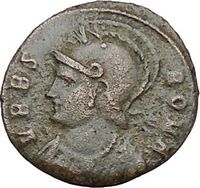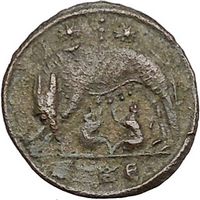|
Constantine I 'The Great'
-
Roman Emperor
: 307-337 A.D. -
ROME CITY COMMEMORATIVE
Bronze AE3 18mm (1.85 grams) Cyzicus mint: 330-335 A.D.
Reference: RIC 72 (VII, Cyzicus)
VRBSROMA - Roma helmeted, draped and cuirassed bust left.
No legend Exe: .SMKЄ - wolf standing left, suckling Romulus and Remus; two stars
above.
Three dots between stars above.
By circa 330 A.D., Constantine the Great completed his new
capital for the Roman empire called Constantinople. For this momentous
occasion, he issued two commemorative coin types, one celebrating Rome and the
other Constantinople. The type that
commemorated Rome
had the
personification of Rome, Roma with the inscription VRBS ROMA and the founders of
Rome, Romulus and Remus on the reverse suckling the she-wolf. The type that
commemorated Constantinople
had
the personification of Constantinople on the obverse and Victory on a galley
sailing with a shield. This was a great way for Constantine the Great to pay
homage to both Rome and Constantinople.
You are bidding on the exact item pictured,
provided with a Certificate of Authenticity and Lifetime Guarantee of
Authenticity.
Romulus and Remus are the twin brothers and central characters
of
Rome's foundation myth
. Their mother is
Rhea Silvia
, daughter to
Numitor
, king of
Alba Longa
. Before their conception, Numitor's
brother Amulius
seizes power, kills Numitor's male
heirs and forces Rhea Silvia to become a
Vestal Virgin
, sworn to
chastity
. Rhea Silvia conceives the twins by
the god
Mars
, or by the demi-god
Hercules
; once the twins are born, Amulius has
them
abandoned to die
in the river
Tiber
. They are saved by a series of miraculous
interventions: the river carries them to safety, a she-wolf (in
Latin
, lupa) finds and
suckles
them, and a
woodpecker
feeds them.
A shepherd
and
his wife
find them and
foster
them to manhood, as simple shepherds.
The twins, still ignorant of their true origins, prove to be natural leaders.
Each acquires many followers. When they discover the truth of their birth, they
kill Amulius and restore Numitor to his throne. Rather than wait to inherit Alba
Longa, they choose to found a new city.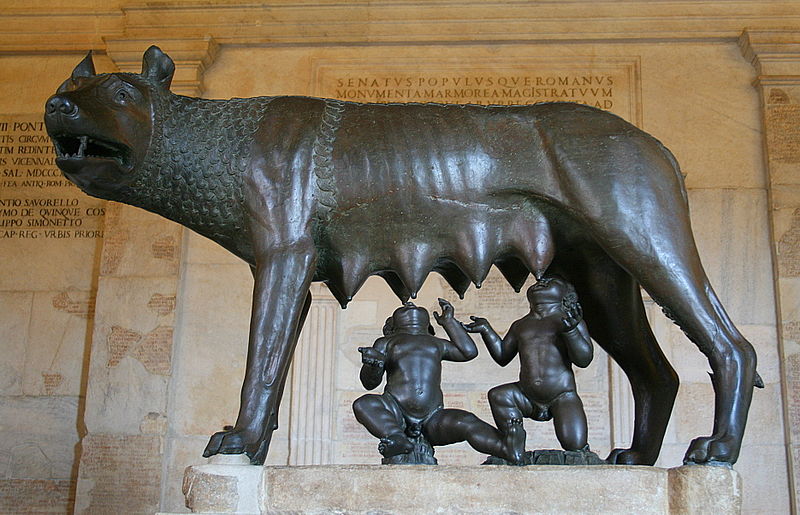
Romulus wants to found the new city on the
Palatine Hill
; Remus prefers the
Aventine Hill
. They agree to determine the site
through augury
but when each claims the results in his
own favor, they quarrel and Remus is killed. Romulus founds the new city, names
it Rome
, after himself, and creates its first
legions
and
senate
. The new city grows rapidly, swelled by
landless refugees; as most of these are male, and unmarried, Romulus arranges
the abduction of women from the neighboring
Sabines
. The ensuing war ends with the joining
of Sabines and Romans as one Roman people. Thanks to divine favour and Romulus'
inspired leadership, Rome becomes a dominant force, but Romulus himself becomes
increasingly autocratic, and disappears or dies in mysterious circumstances. In
later forms of the myth, he ascends to heaven, and is identified with
Quirinus
, the divine personification of the
Roman people.
The legend as a whole encapsulates Rome's ideas of itself, its origins and
moral values. For modern scholarship, it remains one of the most complex and
problematic of all foundation myths, particularly in the matter and manner of
Remus' death. Ancient historians had no doubt that Romulus gave his name to the
city. Most modern historians believe his name a
back-formation
from the name Rome; the basis
for Remus' name and role remain subjects of ancient and modern speculation. The
myth was fully developed into something like an "official", chronological
version in the Late Republican and early Imperial era; Roman historians dated
the city's foundation to between 758 and 728 BC, and
Plutarch
reckoned the twins' birth year as c.
27/28 March 771 BC. An earlier tradition that gave Romulus a distant ancestor in
the semi-divine Trojan
prince
Aeneas
was further embellished, and Romulus was
made the direct ancestor of Rome's first Imperial dynasty. Possible historical
bases for the broad mythological narrative remain unclear and disputed.[4]
The image of the she-wolf suckling the divinely fathered twins became an iconic
representation of the city and its founding legend, making Romulus and Remus
preeminent among the
feral children of ancient mythography
.
The legend in
ancient sources
Modern scholarship approaches the various known stories of Romulus and Remus
as cumulative elaborations and later interpretations of Roman
foundation-myth
. Particular versions and
collations were presented by Roman historians as authoritative, an official
history trimmed of contradictions and untidy variants to justify contemporary
developments, genealogies and actions in relation to
Roman morality
. Other narratives appear to
represent popular or folkloric tradition; some of these remain inscrutable in
purpose and meaning. Wiseman sums the whole as the
mythography
of an unusually problematic
foundation and early history. Cornell and others describe particular elements of
the mythos as "shameful". Nevertheless, by the 4th century BC, the fundamentals
of the Romulus and Remus story were standard Roman fare, and by 269 BC the wolf
and suckling twins appeared on one of the earliest, if not the earliest issues
of Roman silver coinage. Rome's
foundation story
was evidently a matter of
national pride. It featured in the earliest known
history of Rome
, which was attributed to
Diocles of Peparethus
. The patrician senator
Quintus Fabius Pictor
used Diocles' as a source
for his own history of Rome, written around the time of
Rome's war with Hannibal
and probably intended
for circulation among Rome's Greek-speaking allies.
Fabius' history provided a basis for the early books of Livy's
Ab Urbe Condita
, which he wrote in
Latin
, and for several Greek-language histories
of Rome, including
Dionysius of Halicarnassus
's Roman
Antiquities, written during the late 1st century BC, and
Plutarch
's early 2nd century Life of Romulus.
These three accounts provide the broad literary basis for studies of Rome's
founding mythography. They have much in common, but each is selective to its
purpose. Livy's is a dignified handbook, justifying the purpose and morality of
Roman traditions observed in his own times. Dionysius and Plutarch approach the
same subjects as interested outsiders, and include founder-traditions not
mentioned by Livy, untraceable to a common source and probably specific to
particular regions, social classes or oral traditions.A Roman text of the late
Imperial era,
Origo gentis Romanae
(The origin of the
Roman people) is dedicated to the many "more or less bizarre", often
contradictory variants of Rome's foundation myth, including versions in which
Remus founds a city named Remuria, five miles from Rome, and outlives his
brother Romulus.
Stories of
ancestry and parentage
There are several variations on the basic legendary tale.
Plutarch presents Romulus and Remus' ancient descent from prince
Aeneas
, fugitive from
Troy after its destruction by the
Achaeans
. Their maternal grandfather is his
descendant Numitor
, who inherits the kingship of
Alba Longa
. Numitor’s brother
Amulius
inherits its treasury, including the
gold brought by Aeneas from Troy. Amulius uses his control of the treasury to
dethrone Numitor, but fears that Numitor's daughter,
Rhea Silvia
, will bear children who could
overthrow him.
Amulius forces Rhea Silvia into perpetual virginity as a
Vestal
priestess, but she bears children
anyway. In one variation of the story,
Mars
, god of war, seduces and impregnates her:
in another, Amulius himself seduces her, and in yet another, Hercules.
The king sees his niece's pregnancy and confines her. She gives birth to twin
boys of remarkable beauty; her uncle orders her death and theirs. One account
holds that he has Rhea buried alive – the standard punishment for
Vestal Virgins
who violated their vow of
celibacy
– and orders the death of the twins by
exposure
; both means would avoid his direct
blood-guilt. In another, he has Rhea and her twins thrown into the
River Tiber
.
In every version, a servant is charged with the deed of killing the twins,
but cannot bring himself to harm them. He places them in a basket and leaves it
on the banks of the Tiber. The river rises in flood and carries the twins
downstream, unharmed.[16]

Altar from
Ostia
showing the discovery of
Romulus and Remus (now at the
Palazzo Massimo alle Terme
).
The
river deity
Tiberinus
makes the basket catch in the roots
of a fig tree that grows in the
Velabrum
swamp at the base of the
Palatine Hill
. The twins are found and suckled
by a
she-wolf
(Lupa) and fed by a woodpecker
(Picus). A shepherd of Amulius named
Faustulus
discovers them and takes them to his
hut, where he and his wife
Acca Larentia
raise them as their own children.
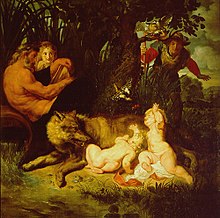
Faustulus (to the right of picture) discovers Romulus and Remus with
the she-wolf and woodpecker. Their mother Rhea Silvia and the
river-god Tiberinus witness the moment. Painting by
Peter Paul Rubens
, c. 1616 (Capitoline
Museums).
In another variant,
Hercules
impregnates
Acca Larentia
and marries her off to the
shepherd Faustulus. She has twelve sons; when one of them dies, Romulus takes
his place to found the priestly college of Arval brothers
Fratres Arvales
. Acca Larentia is therefore
identified with the Arval goddess
Dea Dia
, who is served by the Arvals. In later
Republican religious tradition, a Quirinal priest (flamen)
impersonated Romulus (by then deified as
Quirinus
) to perform funerary rites for his
foster mother (identified as Dia).
Another and probably late tradition has Acca Larentia as a sacred prostitute
(one of many Roman slangs for prostitute was lupa (she-wolf)).
Yet another tradition relates that Romulus and Remus are nursed by the
Wolf-Goddess Lupa or Luperca in her cave-lair (lupercal).
Luperca was given cult for her protection of sheep from wolves and her spouse
was the Wolf-and-Shepherd-God
Lupercus
, who brought fertility to the flocks.
She has been identified with Acca Larentia.
Founding of Rome
In all versions of the founding myth, the twins grew up as shepherds. While
tending their flocks, they came into conflict with the shepherds of
Amulius
. Remus was captured and brought before
Amulius, who eventually discovers his identity. Romulus raised a band of
shepherds to liberate his brother and Amulius was killed. Romulus and Remus were
conjointly offered the crown but they refused it and restored
Numitor
to the throne. They left to found their
own city, but could not agree on its location; Romulus preferred the
Palatine Hill
, Remus preferred the
Aventine Hill
. They agreed to seek the will of
the gods in this matter, through
augury
. Each took position on his respective
hill and prepared a
sacred space
there. Remus saw six auspicious
birds; but Romulus saw twelve. Romulus claimed superior augury as the divine
basis of his right to decide. Remus made a counterclaim: he saw his six vultures
first. Romulus set to work with his supporters, digging a trench (or building a
wall, according to Dionysius) around the Palatine to define his city boundary.
Death of Remus
Livy gave two versions of Remus' death. In the one "more generally received",
Remus criticized and belittles the new wall, and in a final insult to the new
city and its founder alike, he leapt over it. Romulus killed him, saying "So
perish every one that shall hereafter leap over my wall". In the other version,
Remus was simply stated as dead; no murder was alleged. Two other, lesser known
accounts have Remus killed by a blow to the head with a spade, wielded either by
Romulus' commander
Fabius
(according to St. Jerome's version) or
by a man named
Celer
. Romulus buried Remus with honour and
regret. The Roman
ab urbe condita
began from the founding of
the city, and places that date as 21 April 753 BC.
City of Rome
Romulus completed his city and named it
Roma after himself. Then he divided his fighting men into
regiments of 3000 infantry and 300 cavalry, which he called "legions". From the
rest of the populace he selected 100 of the most noble and wealthy fathers to
serve as his council. He called these men
Patricians
: they were fathers of Rome, not only
because they cared for their own legitimate citizen-sons but because they had a
fatherly care for Rome and all its people. They were also its elders, and were
therefore known as
Senators
. Romulus thereby inaugurated a system
of government and social hierarchy based on the
patron-client relationship
.
Rome drew exiles, refugees, the dispossessed, criminals and runaway slaves.
The city expanded its boundaries to accommodate them; five of the
seven hills of Rome
were settled: the
Capitoline Hill
, the
Aventine Hill
, the
Caelian Hill
, the
Quirinal Hill
, and the
Palatine Hill
. As most of these immigrants were
men, Rome found itself with a shortage of marriageable women. Romulus invited
the neighboring
Sabines
and
Latins
, along with their womenfolk, to a
festival at the
Circus Maximus
, in honour of
Consus
(or of
Neptune
). While the men were distracted by the
games and befuddled with wine, the Romans
seized their daughters
and took them into the
city. Most were eventually persuaded to marry Roman men.
War with the Sabines
The Sabine and Latin men demanded the return of their daughters. The
inhabitants of three Latin towns (Caenina,
Antemnae
and
Crustumerium
) took up arms one after the other
but were soundly defeated by Romulus, who killed Acron, the king of Caenina,
with his own hand and celebrates the first
Roman triumph
shortly after. Romulus was
magnanimous in victory – most of the conquered land was divided among Rome's
citizens but none of the defeated are enslaved.
The Sabine king
Titus Tatius
marched on Rome to assault its
Capitoline
citadel. The citadel commander's
daughter Tarpeia
opened the gates for them, in return
for "what they wear on their left arms". She expected their golden bracelets.
Once inside, the Sabines crushed her to death under a pile of their shields.

Romulus, Victor over Acron, hauls the rich booty to the temple of
Jupiter, by
Jean Auguste Dominique Ingres
The Sabines left the citadel to meet the Romans in open battle in the space
later known as the
comitium
. The outcome hung in the balance; the
Romans retreated to the Palatine Hill, where Romulus called on
Jupiter
for help – traditionally at the place
where a
Statortemple to Jupiter
("the stayer") was built. The Romans drove the Sabines back to the point where
the Curia Hostilia
later stood.
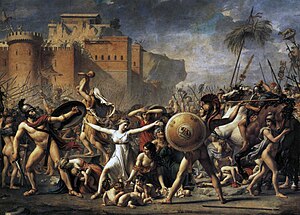
The Sabine Women, by
Jacques-Louis David
The Sabine women themselves then intervened to beg for unity between Sabines
and Romans. A truce was made, then peace. The Romans based themselves on the
Palatine and the Sabines on the
Quirinal
, with Romulus and Tatius as joint
kings and the Comitium as the common centre of government and culture. 100
Sabine elders and clan leaders joined the Patrician Senate. The Sabines adopted
the Roman calendar, and the Romans adopted the armour and oblong shield of the
Sabines. The legions were doubled in size.
Organization and
growth
Romulus and Tatius ruled jointly for five years and subdued the Alban colony
of the Camerini. Then Tatius sheltered some allies who had illegally plundered
the Lavinians, and murdered ambassadors sent to seek justice. Romulus and the
Senate decided that Tatius should go to Lavinium to offer sacrifice and appease
his offence. At Lavinium, Tatius was assassinated and Romulus became sole king.
As king, Romulus held authority over Rome's armies and judiciary. He
organises Rome's administration according to tribe; one of
Latins
(Ramnes), one of Sabines (Titites),
and one of Luceres. Each elected a tribune to represented their civil,
religious, and military interests. The tribunes were magistrates of their
tribes, performed sacrifices on their behalf, and commanded their tribal levies
in times of war.
Romulus divided each tribe into ten
curiae
to form the
Comitia Curiata
. The thirty
curiae
derived their individual names from
thirty of the kidnapped Sabine women.
The individual curiae were further divided into ten
gentes, held to form the basis for the
nomen
in the Roman naming convention. Proposals
made by Romulus or the Senate were offered to the Curiate assembly for
ratification; the ten gentes within each curia cast a vote. Votes were carried
by whichever gens has a majority.
Romulus formed a personal guard called the
Celeres
; these were three hundred of Rome's
finest horsemen. They were commanded by a tribune of the Ramnes; in one version
of the founding tale, Celer killed Remus and helped Romulus found the city of
Rome. The provision of a personal guard for Romulus helped justify the Augustan
development of a
Praetorian Guard
, responsible for internal
security and the personal safety of the Emperor. The relationship between
Romulus and his Tribune resembled the later relation between the
Roman Dictator
and his
Magister Equitum
. Celer, as the Celerum
Tribune
, occupied the second place in the
state, and in Romulus' absence had the rights of convoking the Comitia and
commanding the armies.
For more than two decades, Romulus waged wars and expands Rome's territory.
He subdues Fidenae
, which seized Roman provisions during a
famine, and founded a Roman colony there. Then he subdued the Crustumini, who
had murdered Roman colonists in their territory. The
Etruscans
of
Veii protested the presence of a Roman garrison at Fidenae, and
demanded the return of the town to its citizens. When Romulus refused, they
confronted him in battle and were defeated. They agreed to a hundred-year truce
and surrendered fifty noble hostages: Romulus celebrated his third and last
triumph.
When Romulus' grandfather
Numitor
died, the people of
Alba Longa
offered him the crown as rightful
heir. Romulus adapted the government of the city to a Roman model. Henceforth,
the citizens held annual elections and choose one of their own as Roman
governor.
In Rome, Romulus began to show signs of autocratic rule. The Senate becomes
less influential in administration and lawmaking; Romulus ruled by
edict
. He divided his conquered territories
among his soldiers without Patrician consent. Senatorial resentment grew to
hatred.
Death of Romulus
According to the legend, Romulus mysteriously disappeared in a storm or
whirlwind, during or shortly after offering public sacrifice at or near the
Quirinal Hill. A "foul suspicion" arises that the Senate, weary of kingly
government, and exasperated of late by the imperious deportment of Romulus
toward them, had plotted against his life and made him away, so that they might
assume the authority and government into their own hands. This suspicion they
sought to turn aside by decreeing divine honors to Romulus, as to one not dead,
but translated to a higher condition. And Proculus, a man of note, took oath
that he saw Romulus caught up into heaven in his arms and vestments, and heard
him, as he ascended, cry out that they should hereafter style him by the name of
Quirinus.
Livy repeats more or less the same story, but shifts the initiative for
deification to the people of Rome:
Then a few voices began to proclaim Romulus's divinity; the cry was taken
up, and at last every man present hailed him as a god and son of a god, and
prayed to him to be forever gracious and to protect his children. However,
even on this great occasion there were, I believe, a few dissenters who
secretly maintained that the king had been torn to pieces by the senators.
At all events the story got about, though in veiled terms; but it was not
important, as awe, and admiration for Romulus's greatness, set the seal upon
the other version of his end, which was, moreover, given further credit by
the timely action of a certain Julius Proculus, a man, we are told, honored
for his wise counsel on weighty matters. The loss of the king had left the
people in an uneasy mood and suspicious of the senators, and Proculus, aware
of the prevalent temper, conceived the shrewd idea of addressing the
Assembly. 'Romulus', he declared, 'the father of our city descended from
heaven at dawn this morning and appeared to me. In awe and reverence I stood
before him, praying for permission to look upon his face without sin. Go,
he said, and tell the Romans that by heaven's will my
Rome shall be capital of the world
. Let
them learn to be soldiers. Let them know, and teach their children, that no
power on earth can stand against Roman arms. Having spoken these words,
he was taken up again into the sky"
Livy infers Romulus' murder as no more than a dim and doubtful whisper from
the past; in the circumstances, Proculus' declaration is wise and practical
because it has the desired effect. Cicero's seeming familiarity with the story
of Romulus' murder and divinity must have been shared by his target audience and
readership. Dio's version, though fragmentary, is unequivocal; Romulus is
surrounded by hostile, resentful senators and "rent limb from limb" in the
senate-house itself. An eclipse and sudden storm, "the same sort of phenomenon
that had attended his birth", conceal the deed from the soldiers and the people,
who are anxiously seeking their king. Proculus fakes a personal vision of
Romulus' spontaneous ascent to heaven as Quirinus and announces the message of
Romulus-Quirinus; a new king must be chosen at once. A dispute arises: should
this king be Sabine or Roman? The debate goes on for a year. During this time,
the most distinguished senators rule for five days at a time as
interreges
.
Alleged dates
Plutarch says that Romulus was 53 ("in the fifty-fourth year of his age")
when he "vanished" in 717 BC; this gives the twins a birth-date in the year 771
BC, and Romulus' founding of Rome at the age of 18.
Dionysius of Halicarnassus
says that Romulus
began his reign at 18, ruled for 37 years and died at 55 years old.
Romulus-Quirinus
Ennius
(fl. 180s BC) refers to Romulus as a
divinity without reference to Quirinus, whom Roman mythographers identified as
an originally Sabine war-deity, and thus to be identified with Roman
Mars
.
Lucilius
lists Quirinus and Romulus as separate
deities, and
Varro
accords them different temples. Images of
Quirinus showed him as a bearded warrior wielding a spear as a god of war, the
embodiment of Roman strength and a deified likeness of the city of Rome. He had
a Flamen Maior
called the
Flamen Quirinalis
, who oversaw his worship and
rituals in the ordainment of Roman religion attributed to Romulus' royal
successor,
Numa Pompilius
. There is however no evidence
for the conflated Romulus-Quirinus before the 1st century BC.
Ovid
in Book 14, lines 812-828, of the
Metamorphoses
gives a description of the
deification of Romulus and his wife
Hersilia
, who are given the new names of
Quirinus and Hora respectively. Mars, the father of Romulus, is given permission
by
Jupiter
to bring his son up to Olympus to live
with the
Olympians
. Ovid uses the words of Ennius as a
direct quote and puts them into the mouth of the King of the Gods, "There shall
be one whom you shall raise to the blue vault of heaven". Ovid then uses a
simile to describe the change that Romulus undertakes as he ascends to live with
the Olympians, "as leaden balls from a broad sling melt in mid sky: Finer his
features now and worthier of heaven’s high-raised couch, his lineaments those of
Quirinus in his robe of state”.
Iconography

Romulus and Remus. Silver
didrachm
(6.44 g). c. 269–266 BC
Ancient pictures of the Roman twins usually follow certain
symbolic
traditions, depending on the legend
they follow: they either show a shepherd, the she-wolf, the twins under a fig
tree, and one or two birds (Livy,
Plutarch
); or they depict two shepherds, the
she-wolf, the twins in a cave, seldom a fig tree, and never any birds (Dionysius
of Halicarnassus).
Also there are coins with Lupa and the tiny twins placed beneath her.
The
Franks Casket
, an Anglo-Saxon ivory box (early
7th century AD) shows Romulus and Remus in an unusual setting, two wolves
instead of one, a grove instead of one tree or a cave, four kneeling warriors
instead of one or two gesticulating shepherds. According to one interpretation,
and as the
runic
inscription ("far from home") indicates,
the twins are cited here as the Dioscuri, helpers at voyages such as
Castor and Polydeuces
. Their descent from the
Roman god of war predestines them as helpers on the way to war. The carver
transferred them into the Germanic holy grove and has
Woden
’s second wolf join them. Thus the picture
served — along with five other ones — to influence "wyrd",
the fortune and fate of a warrior king.
In popular culture
-
Romolo e Remo
: a 1961 film starring
Steve Reeves
and
Gordon Scott
as the two brothers.
-
The Rape of the Sabine Women
: a 1962
film starring
Wolf Ruvinskis
as Romulus.
- In the
Star Trek
universe, Romulus and Remus
are neighbouring
planets
with Remus being
tidally locked
to the star. Romulus is the
capital of the
Romulan Star Empire
, which is loosely based
on the
Roman Empire
.
- The novel Founding Fathers by
Alfred Duggan
describes the founding and
first decades of Rome from the points of view of Marcus, one of Romulus's
Latin followers, Publius, a Sabine who settles in Rome as part of the peace
agreement with Tatius, Perperna, an Etruscan fugitive who is accepted into
the tribe of Luceres after his own city is destroyed, and Macro, a Greek
seeking purification from blood-guilt who comes to the city in the last
years of Romulus' reign. Publiusa and Perpernia become senators. Romulus is
portrayed as a gifted leader though a remarkably unpleasant person, chiefly
distinguished by his luck; the story of his surreptitious murder by the
senators is adopted, but although the story of his deification is
fabricated, his murderers themselves think he may indeed have become a god.
The novel begins with the founding of the city and the killing of Remus, and
ends with the accession of Numa Pompilius.
- In the game
Undead Knights
, the main characters are
brothers named Romulus and Remus.
Constantine the Great (Latin:
Flavius Valerius Aurelius Constantinus Augustus;
27 February c. 272 – 22 May 337), also known as Constantine I or Saint
Constantine, was
Roman Emperor
from 306 to 337. Well known for
being the first Roman emperor to
be converted
to
Christianity
, Constantine and co-Emperor
Licinius
issued the
Edict of Milan
in 313, which proclaimed
tolerance of all religions
throughout the
empire.
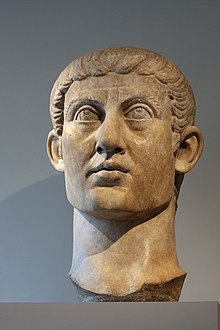
Constantine defeated the emperors
Maxentius
and
Licinius
during civil wars. He also fought
successfully against the
Franks
,
Alamanni
,
Visigoths
, and
Sarmatians
during his reign — even resettling
parts of Dacia
which had been abandoned during the
previous century. Constantine built a new imperial residence at
Byzantium
, naming it
New Rome
. However, in Constantine's honor,
people called it
Constantinople
, which would later be the
capital of what is now known as the
Byzantine Empire
for over one thousand years.
Because of this, he is thought of as the founder of the Byzantine Empire.
Flavius Valerius Constantinus, as he was originally named, was born in the
city of Naissus,
Dardania
province of
Moesia
, in present-day
Niš,
Serbia
, on 27 February of an uncertain year,
probably near 272.
His father was
Flavius Constantius
, a native of
Dardania
province of Moesia (later
Dacia Ripensis
). Constantius was a tolerant and
politically skilled man. Constantine probably spent little time with his father.
Constantius was an officer in the Roman army, part of the Emperor
Aurelian
's imperial bodyguard. Constantius
advanced through the ranks, earning the
governorship
of
Dalmatia
from Emperor
Diocletian
, another of Aurelian's companions
from
Illyricum
, in 284 or 285.Constantine's mother
was
Helena
, a
Bithynian
woman of low social standing.It is
uncertain whether she was legally married to Constantius or merely his concubine
Helena gave birth to the future emperor
Constantine I
on 27 February of an uncertain
year soon after 270 (probably around 272). At the time, she was in
Naissus
(Niš,
Serbia
). In order to obtain a wife more
consonant with his rising status, Constantius divorced Helena some time before
289, when he married
Theodora
, Maximian's daughter.(The narrative
sources date the marriage to 293, but the
Latin panegyric
of 289 refers to the couple as
already married). Helena and her son were dispatched to the court of
Diocletian
at Nicomedia, where Constantine grew
to be a member of the inner circle. Helena never remarried and lived for a time
in obscurity, though close to her only son, who had a deep regard and affection
for her.
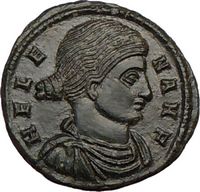
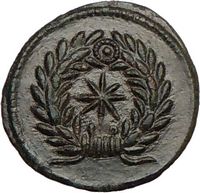
She received the title of
Augusta
in 325 and died in 330 with her son
at her side. She was buried in the
Mausoleum of Helena
, outside
Rome on the
Via Labicana
. Her
sarcophagus
is on display in the
Pio-Clementine Vatican Museum
, although the
connection is often questioned, next to her is the sarcophagus of her
granddaughter Saint Constantina (Saint Constance). The elaborate reliefs contain
hunting scenes. During her life, she gave many presents to the poor, released
prisoners and mingled with the ordinary worshippers in modest attire.
Constantine received a formal education at Diocletian's court, where he
learned Latin literature, Greek, and philosophy.
On 1 May 305, Diocletian, as a result of a debilitating sickness taken in the
winter of 304–5, announced his resignation. In a parallel ceremony in Milan,
Maximian did the same. Lactantius states that Galerius manipulated the weakened
Diocletian into resigning, and forced him to accept Galerius' allies in the
imperial succession. According to Lactantius, the crowd listening to
Diocletian's resignation speech believed, until the very last moment, that
Diocletian would choose Constantine and
Maxentius
(Maximian's son) as his successors.
It was not to be: Constantius and Galerius were promoted to Augusti, while
Severus
and
Maximin
were appointed their Caesars
respectively. Constantine and Maxentius were ignored.
Constantine recognized the implicit danger in remaining at Galerius' court,
where he was held as a virtual hostage. His career depended on being rescued by
his father in the west. Constantius was quick to intervene. In the late spring
or early summer of 305, Constantius requested leave for his son, to help him
campaign in Britain. After a long evening of drinking, Galerius granted the
request. Constantine's later propaganda describes how he fled the court in the
night, before Galerius could change his mind. He rode from
post-house
to post-house at high speed,
hamstringing
every horse in his wake.By the
time Galerius awoke the following morning, Constantine had fled too far to be
caught. Constantine joined his father in
Gaul
, at Bononia (Boulogne)
before the summer of 305.
From Bononia they crossed the
Channel
to Britain and made their way to
Eboracum
(York),
capital of the province of
Britannia Secunda
and home to a large military
base. Constantine was able to spend a year in northern Britain at his father's
side, campaigning against the
Picts
beyond
Hadrian's Wall
in the summer and autumn.
Constantius's campaign, like that of
Septimius Severus
before it, probably advanced
far into the north without achieving great success. Constantius had become
severely sick over the course of his reign, and died on 25 July 306 in
Eboracum
(York).
Before dying, he declared his support for raising Constantine to the rank of
full Augustus. The
Alamannic
king
Chrocus
, a barbarian taken into service under
Constantius, then proclaimed Constantine as Augustus. The troops loyal to
Constantius' memory followed him in acclamation. Gaul and Britain quickly
accepted his rule; Iberia, which had been in his father's domain for less than a
year, rejected it.
Constantine sent Galerius an official notice of Constantius's death and his
own acclamation. Along with the notice, he included a portrait of himself in the
robes of an Augustus. The portrait was wreathed in
bay
. He requested recognition as heir to his
father's throne, and passed off responsibility for his unlawful ascension on his
army, claiming they had "forced it upon him".Galerius was put into a fury by the
message; he almost set the portrait on fire. His advisers calmed him, and argued
that outright denial of Constantine's claims would mean certain war.Galerius was
compelled to compromise: he granted Constantine the title "Caesar" rather than
"Augustus" (the latter office went to Severus instead). Wishing to make it clear
that he alone gave Constantine legitimacy, Galerius personally sent Constantine
the emperor's traditional
purple robes
. Constantine accepted the
decision. Constantine's share of the Empire consisted of Britain, Gaul, and
Spain.
Because Constantine was still largely untried and had a hint of illegitimacy
about him, he relied on his father's reputation in his early propaganda: the
earliest panegyrics to Constantine give as much coverage to his father's deeds
as to those of Constantine himself.
Constantine's military skill and building projects soon gave
the panegyrist the opportunity to comment favorably on the similarities between
father and son, and Eusebius remarked that Constantine was a "renewal, as it
were, in his own person, of his father's life and reign". Constantinian coinage,
sculpture and oratory also shows a new tendency for disdain towards the
"barbarians" beyond the frontiers. After Constantine's victory over the
Alemanni, he minted a coin issue depicting weeping and begging Alemannic
tribesmen—"The Alemanni conquered"—beneath the phrase "Romans' rejoicing".There
was little sympathy for these enemies. As his panegyrist declared: "It is a
stupid clemency that spares the conquered foe."

In 310, a dispossessed and power-hungry Maximian rebelled against Constantine
while Constantine was away campaigning against the Franks. Maximian had been
sent south to Arles with a contingent of Constantine's army, in preparation for
any attacks by Maxentius in southern Gaul. He announced that Constantine was
dead, and took up the imperial purple. In spite of a large donative pledge to
any who would support him as emperor, most of Constantine's army remained loyal
to their emperor, and Maximian was soon compelled to leave. Constantine soon
heard of the rebellion, abandoned his campaign against the Franks, and marched
his army up the Rhine. At Cabillunum (Chalon-sur-Saône),
he moved his troops onto waiting boats to row down the slow waters of the
Saône
to the quicker waters of the
Rhone
. He disembarked at
Lugdunum
(Lyon).Maximian
fled to Massilia (Marseille),
a town better able to withstand a long siege than Arles. It made little
difference, however, as loyal citizens opened the rear gates to Constantine.
Maximian was captured and reproved for his crimes. Constantine granted some
clemency, but strongly encouraged his suicide. In July 310, Maximian hanged
himself.
The death of Maximian required a shift in Constantine's public image. He
could no longer rely on his connection to the elder emperor Maximian, and needed
a new source of legitimacy.In a speech delivered in Gaul on 25 July 310, the
anonymous orator reveals a previously unknown dynastic connection to
Claudius II
, a third-century emperor famed for
defeating the Goths and restoring order to the empire. Breaking away from
tetrarchic models, the speech emphasizes Constantine's ancestral prerogative to
rule, rather than principles of imperial equality. The new ideology expressed in
the speech made Galerius and Maximian irrelevant to Constantine's right to rule.
Indeed, the orator emphasizes ancestry to the exclusion of all other factors:
"No chance agreement of men, nor some unexpected consequence of favor, made you
emperor," the orator declares to Constantine.
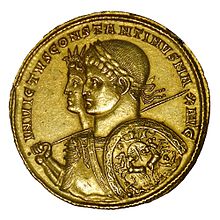
A gold multiple of "Unconquered Constantine" with
Sol
Invictus, struck in 313. The use of Sol's image appealed to both the
educated citizens of Gaul, who would recognize
in it Apollo's patronage of
Augustus
and the arts; and to Christians, who found solar monotheism less
objectionable than the traditional pagan pantheon.
The oration also moves away from the religious ideology of the Tetrarchy,
with its focus on twin dynasties of
Jupiter
and
Hercules
. Instead, the orator proclaims that
Constantine experienced a divine vision of
Apollo
and
Victory
granting him
laurel wreaths
of health and a long reign. In
the likeness of Apollo Constantine recognized himself as the saving figure to
whom would be granted "rule of the whole world", as the poet Virgil had once
foretold. The oration's religious shift is paralleled by a similar shift in
Constantine's coinage. In his early reign, the coinage of Constantine advertised
Mars
as his patron. From 310 on, Mars was
replaced by
Sol Invictus
, a god conventionally identified
with Apollo.
By the middle of 310, Galerius had become too ill to involve himself in
imperial politics. His final act survives: a letter to the provincials posted in
Nicomedia on 30 April 311, proclaiming an end to the persecutions, and the
resumption of religious toleration. He died soon after the edict's proclamation,
destroying what little remained of the tetrarchy. Maximin mobilized against
Licinius, and seized Asia Minor. A hasty peace was signed on a boat in the
middle of the Bosphorus. While Constantine toured Britain and Gaul, Maxentius
prepared for war.He fortified northern Italy, and strengthened his support in
the Christian community by allowing it to elect a new
Bishop
of
Rome
,
Eusebius
.
Constantine's advisers and generals cautioned against preemptive attack on
Maxentius; even his soothsayers recommended against it, stating that the
sacrifices had produced unfavorable omens. Constantine, with a spirit that left
a deep impression on his followers, inspiring some to believe that he had some
form of supernatural guidance, ignored all these cautions. Early in the spring
of 312,Constantine crossed the
Cottian Alps
with a quarter of his army, a
force numbering about 40,000.The first town his army encountered was Segusium (Susa,
Italy
), a heavily fortified town that shut its
gates to him. Constantine ordered his men to set fire to its gates and scale its
walls. He took the town quickly. Constantine ordered his troops not to loot the
town, and advanced with them into northern Italy.
At the approach to the west of the important city of Augusta Taurinorum (Turin,
Italy), Constantine met a large force of heavily armed Maxentian cavalry. In the
ensuing
battle
Constantine's army encircled Maxentius'
cavalry, flanked them with his own cavalry, and dismounted them with blows from
his soldiers' iron-tipped clubs. Constantine's armies emerged victorious. Turin
refused to give refuge to Maxentius' retreating forces, opening its gates to
Constantine instead.
Other cities of the north Italian plain sent Constantine
embassies of congratulation for his victory. He moved on to Milan, where he was
met with open gates and jubilant rejoicing. Constantine rested his army in Milan
until mid-summer 312, when he moved on to
Brixia
(Brescia).
Brescia's army was easily dispersed, and Constantine quickly advanced to
Verona
, where a large Maxentian force was
camped. Ruricius Pompeianus, general of the Veronese forces and Maxentius'
praetorian prefect, was in a strong defensive position, since the town was
surrounded on three sides by the
Adige
. Constantine sent a small force north of
the town in an attempt to cross the river unnoticed. Ruricius sent a large
detachment to counter Constantine's expeditionary force, but was defeated.
Constantine's forces successfully surrounded the town and laid siege. Ruricius
gave Constantine the slip and returned with a larger force to oppose
Constantine. Constantine refused to let up on the siege, and sent only a small
force to oppose him. In the desperately fought
encounter
that followed, Ruricius was killed
and his army destroyed.Verona surrendered soon afterwards, followed by
Aquileia
, Mutina (Modena),
and
Ravenna
. The road to Rome was now wide open to
Constantine.
Maxentius prepared for the same type of war he had waged against Severus and
Galerius: he sat in Rome and prepared for a siege. He still controlled Rome's
praetorian guards, was well-stocked with African grain, and was surrounded on
all sides by the seemingly impregnable
Aurelian Walls
. He ordered all bridges across
the Tiber
cut, reportedly on the counsel of the
gods, and left the rest of central Italy undefended; Constantine secured that
region's support without challenge. Constantine progressed slowly along the
Via Flaminia
, allowing the weakness of
Maxentius to draw his regime further into turmoil. Maxentius' support continued
to weaken: at chariot races on 27 October, the crowd openly taunted Maxentius,
shouting that Constantine was invincible. Maxentius, no longer certain that he
would emerge from a siege victorious, built a temporary boat bridge across the
Tiber in preparation for a field battle against Constantine. On 28 October 312,
the sixth anniversary of his reign, he approached the keepers of the
Sibylline Books
for guidance. The keepers
prophesied that, on that very day, "the enemy of the Romans" would die.
Maxentius advanced north to meet Constantine in battle.
Maxentius organized his forces—still twice the size of Constantine's—in long
lines facing the battle plain, with their backs to the river. Constantine's army
arrived at the field bearing unfamiliar symbols on either its standards or its
soldiers' shields. Constantine was visited by a dream the night before the
battle, wherein he was advised "to mark the heavenly sign of God on the shields
of his soldiers...by means of a slanted letter X with the top of its head bent
round, he marked Christ on their shields." Eusebius describes the sign as
Chi
(Χ) traversed by
Rho
(Ρ): ☧, a symbol representing the first two
letters of the Greek spelling of the word Christos or Christ.
Constantine deployed his own forces along the whole length of Maxentius'
line. He ordered his cavalry to charge, and they broke Maxentius' cavalry. He
then sent his infantry against Maxentius' infantry, pushing many into the Tiber
where they were slaughtered and drowned. The battle was brief: Maxentius' troops
were broken before the first charge. Maxentius' horse guards and praetorians
initially held their position, but broke under the force of a Constantinian
cavalry charge; they also broke ranks and fled to the river. Maxentius rode with
them, and attempted to cross the bridge of boats, but he was pushed by the mass
of his fleeing soldiers into the Tiber, and drowned.
In Rome
Constantine entered Rome on 29 October.He staged a grand
adventus
in the city, and was met with
popular jubilation. Maxentius' body was fished out of the Tiber and decapitated.
His head was paraded through the streets for all to see. Unlike his
predecessors, Constantine neglected to make the trip to the
Capitoline Hill
and perform customary
sacrifices at the
Temple of Jupiter
. He did, however, choose to
honor the
Senatorial
Curia
with a visit, where he promised to
restore its ancestral privileges and give it a secure role in his reformed
government: there would be no revenge against Maxentius' supporters.In response,
the Senate decreed him "title of the first name", which meant his name would be
listed first in all official documents, and acclaimed him as "the greatest
Augustus". He issued decrees returning property lost under Maxentius, recalling
political exiles, and releasing Maxentius' imprisoned opponents.
In the following years, Constantine gradually consolidated his military
superiority over his rivals in the crumbling Tetrarchy. In 313, he met
Licinius
in
Milan
to secure their alliance by the marriage
of Licinius and Constantine's half-sister
Constantia
. During this meeting, the emperors
agreed on the so-called
Edict of Milan
,officially granting full
tolerance to Christianity and all religions in the Empire.The document had
special benefits for Christians, legalizing their religion and granting them
restoration for all property seized during Diocletian's persecution.
In the year 320,
Licinius
reneged on the religious freedom
promised by the
Edict of Milan
in 313 and began to oppress
Christians anew, generally without bloodshed, but resorting to confiscations and
sacking of Christian office-holders.That became a challenge to Constantine in
the West, climaxing in the great civil war of 324. Licinius, aided by
Goth
mercenaries
, represented the past and the
ancient Pagan
faiths. Constantine and his
Franks
marched under the standard of the
labarum
, and both sides saw the battle in
religious terms. Outnumbered, but fired by their zeal, Constantine's army
emerged victorious in the
Battle of Adrianople
. Licinius fled across the
Bosphorus and appointed
Martius Martinianus
, the commander of his
bodyguard, as Caesar, but Constantine next won the
Battle of the Hellespont
, and finally the
Battle of Chrysopolis
on 18 September
324.Licinius and Martinianus surrendered to Constantine at Nicomedia on the
promise their lives would be spared: they were sent to live as private citizens
in Thessalonica and Cappadocia respectively, but in 325 Constantine accused
Licinius of plotting against him and had them both arrested and hanged;
Licinius's son (the son of Constantine's half-sister) was also killed. Thus
Constantine became the sole emperor of the Roman Empire.
Foundation of
Constantinople
Licinius' defeat came to represent the defeat of a rival center of Pagan and
Greek-speaking political activity in the East, as opposed to the Christian and
Latin-speaking Rome, and it was proposed that a new Eastern capital should
represent the integration of the East into the Roman Empire as a whole, as a
center of learning, prosperity, and cultural preservation for the whole of the
Eastern Roman Empire
. Among the various
locations proposed for this alternative capital, Constantine appears to have
toyed earlier with
Serdica
(present-day
Sofia
), as he was reported saying that "Serdica
is my Rome". Sirmium
and
Thessalonica
were also considered. Eventually,
however, Constantine decided to work on the Greek city of
Byzantium
, which offered the advantage of
having already been extensively rebuilt on Roman patterns of urbanism, during
the preceding century, by
Septimius Severus
and
Caracalla
, who had already acknowledged its
strategic importance. The city was then renamed Constantinopolis
("Constantine's City" or
Constantinople
in English), and issued special
commemorative coins in 330 to honor the event. The new city was protected by the
relics of the
True Cross
, the
Rod of Moses
and other holy
relics
, though a cameo now at the
Hermitage Museum
also represented Constantine
crowned by the tyche
of the new city. The figures of old gods
were either replaced or assimilated into a framework of
Christian symbolism
. Constantine built the new
Church of the Holy Apostles
on the site of a
temple to Aphrodite
. Generations later there was the
story that a
divine vision
led Constantine to this spot, and
an angel
no one else could see, led him on a
circuit of the new walls. The capital would often be compared to the 'old' Rome
as Nova Roma Constantinopolitana, the "New Rome of Constantinople".
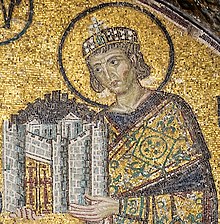
Constantine the Great, mosaic in
Hagia Sophia, c. 1000
Religious policy
Constantine is perhaps best known for being the first "Christian" Roman
emperor. Scholars debate whether Constantine adopted his mother
St. Helena
's
Christianity in his youth, or whether he adopted it gradually over the course of
his life.
Constantine was over 40 when he finally declared himself a Christian, writing to
Christians to make clear that he believed he owed his successes to the
protection of the Christian High God alone.Throughout his rule, Constantine
supported the Church financially, built basilicas, granted privileges to clergy
(e.g. exemption from certain taxes), promoted Christians to high office, and
returned property confiscated during the Diocletianic persecution.His most
famous building projects include the
Church of the Holy Sepulchre
, and
Old Saint Peter's Basilica
.
However, Constantine certainly did not patronize Christianity alone. After
gaining victory in the Battle of the Milvian Bridge (312), a triumphal arch—the
Arch of Constantine
—was built (315) to
celebrate his triumph. The arch is most notably decorated with images of the
goddess
Victoria
and, at the time of its dedication,
sacrifices to gods like
Apollo
,
Diana
, and
Hercules
were made. Most notably absent from
the Arch are any depictions whatsoever regarding Christian symbolism.
Later in 321, Constantine instructed that Christians and non-Christians
should be united in observing the venerable day of the sun, referencing
the sun-worship
that
Aurelian
had established as an official cult.
Furthermore, and long after his oft alleged "conversion" to Christianity,
Constantine's coinage continued to carry the symbols of the sun. Even after the
pagan gods had disappeared from the coinage, Christian symbols appeared only as
Constantine's personal attributes: the
chi rho
between his hands or on his
labarum
, but never on the coin itself. Even
when Constantine dedicated the new capital of Constantinople, which became the
seat of Byzantine Christianity for a millennium, he did so wearing the
Apollonian
sun-rayed
Diadem
; no Christian symbols were present at
this dedication.
Constantine made new laws regarding the
Jews. They were forbidden to own Christian slaves or to
circumcise
their slaves.

Administrative reforms
Beginning in the mid-3rd century the emperors began to favor members of the
equestrian order
over senators, who had had a
monopoly on the most important offices of state. Senators were stripped of the
command of legions and most provincial governorships (as it was felt that they
lacked the specialized military upbringing needed in an age of acute defense
needs), such posts being given to equestrians by Diocletian and his
colleagues—following a practice enforced piecemeal by their predecessors. The
emperors however, still needed the talents and the help of the very rich, who
were relied on to maintain social order and cohesion by means of a web of
powerful influence and contacts at all levels. Exclusion of the old senatorial
aristocracy threatened this arrangement.
In 326, Constantine reversed this pro-equestrian trend, raising many
administrative positions to senatorial rank and thus opening these offices to
the old aristocracy, and at the same time elevating the rank of already existing
equestrians office-holders to senator, eventually wiping out the equestrian
order—at least as a bureaucratic rank—in the process. One could become a
senator, either by being elected
praetor
or (in most cases) by fulfilling a
function of senatorial rank: from then on, holding of actual power and social
status were melded together into a joint imperial hierarchy. At the same time,
Constantine gained with this the support of the old nobility, as the Senate was
allowed itself to elect praetors and
quaestors
, in place of the usual practice of
the emperors directly creating new magistrates (adlectio).
The Senate as a body remained devoid of any significant power; nevertheless,
the senators, who had been marginalized as potential holders of imperial
functions during the 3rd century, could now dispute such positions alongside
more upstart bureaucrats. Some modern historians see in those administrative
reforms an attempt by Constantine at reintegrating the senatorial order into the
imperial administrative elite to counter the possibility of alienating pagan
senators from a Christianized imperial rule.
Constantine's reforms had to do only with the civilian administration: the
military chiefs, who since the
Crisis of the Third Century
had risen from the
ranks, remained outside the senate, in which they were included only by
Constantine's children.

Monetary reforms
After the
runaway inflation of the third century
,
associated with the production of
fiat money
to pay for public expenses,
Diocletian had tried unsuccessfully to reestablish trustworthy minting of silver
and
billon
coins. The failure of the various
Diocletianic attempts at the restoration of a functioning silver coin resided in
the fact that the silver currency was overvalued in terms of its actual metal
content, and therefore could only circulate at much discounted rates. Minting of
the Diocletianic "pure" silver
argenteus
ceased, therefore, soon after
305, while the billon currency continued to be used until the 360s. From the
early 300s on, Constantine forsook any attempts at restoring the silver
currency, preferring instead to concentrate on minting large quantities of good
standard gold pieces—the
solidus
, 72 of which made a pound of gold. New
(and highly debased) silver pieces would continue to be issued during
Constantine's later reign and after his death, in a continuous process of
retariffing, until this billon minting eventually ceased, de jure, in
367, with the silver piece being de facto continued by various
denominations of bronze coins, the most important being the
centenionalis
. Later emperors like
Julian the Apostate
tried to present themselves
as advocates of the humiles by insisting on trustworthy mintings of the
bronze currency.
Constantine's monetary policy were closely associated with his religious
ones, in that increased minting was associated with measures of
confiscation—taken since 331 and closed in 336—of all gold, silver and bronze
statues from pagan temples, who were declared as imperial property and, as such,
as monetary assets. Two imperial commissioners for each province had the task of
getting hold of the statues and having them melded for immediate minting—with
the exception of a number of bronze statues who were used as public monuments
for the beautification of the new capital in Constantinople.
Later campaigns
Constantine considered Constantinople as his capital and permanent residence.
He lived there for a good portion of his later life. He rebuilt Trajan's bridge
across the Danube, in hopes of reconquering
Dacia
, a province that had been abandoned under
Aurelian. In the late winter of 332, Constantine campaigned with the
Sarmatians
against the
Goths
. The weather and lack of food cost the
Goths dearly: reportedly, nearly one hundred thousand died before they submitted
to Rome. In 334, after Sarmatian commoners had overthrown their leaders,
Constantine led a campaign against the tribe. He won a victory in the war and
extended his control over the region, as remains of camps and fortifications in
the region indicate.Constantine resettled some Sarmatian exiles as farmers in
Illyrian and Roman districts, and conscripted the rest into the army.
Constantine took the title Dacicus maximus in 336.
Sickness and death
Constantine had known death would soon come. Within the Church of the Holy
Apostles, Constantine had secretly prepared a final resting-place for himself.It
came sooner than he had expected. Soon after the Feast of Easter 337,
Constantine fell seriously ill. He left Constantinople for the hot baths near
his mother's city of Helenopolis (Altinova), on the southern shores of the Gulf
of İzmit. There, in a church his mother built in honor of Lucian the Apostle, he
prayed, and there he realized that he was dying. Seeking purification, he became
a catechumen
, and attempted a return to
Constantinople, making it only as far as a suburb of Nicomedia. He summoned the
bishops, and told them of his hope to be baptized in the
River Jordan
, where Christ was written to have
been baptized. He requested the baptism right away. The bishops, Eusebius
records, "performed the sacred ceremonies according to custom". He chose the
Arianizing bishop
Eusebius of Nicomedia
, bishop of the
city
where he lay dying, as his baptizer. In
postponing his baptism, he followed one custom at the time which postponed
baptism until after infancy. Constantine died soon after at a suburban villa
called Achyron, on the last day of the fifty-day festival of Pentecost directly
following Pascha (or Easter), on 22 May 337.[246]
Following his death, his body was transferred to Constantinople and buried in
the
Church of the Holy Apostles
there. He was
succeeded by his three sons born of Fausta,
Constantine II
,
Constantius II
and
Constans
. A number of relatives were killed by
followers of Constantius, notably Constantine's nephews
Dalmatius
(who held the rank of Caesar) and
Hannibalianus
, presumably to eliminate possible
contenders to an already complicated succession. He also had two daughters,
Constantina
and
Helena
, wife of
Emperor Julian
.
Legacy
The Byzantine Empire considered Constantine its founder and the
Holy Roman Empire
reckoned him among the
venerable figures of its tradition. In the later Byzantine state, it had become
a great honor for an emperor to be hailed as a "new Constantine". Ten emperors,
including the last emperor of Byzantium, carried the name. Most Eastern
Christian churches consider Constantine a saint (Άγιος Κωνσταντίνος, Saint
Constantine). In the Byzantine Church he was called isapostolos (Ισαπόστολος
Κωνσταντίνος) —an
equal of the Apostles
.
Niš airport
is named Constantine the Great in
honor of his birth in Naissus.
|
